In an era where smartphones are often designed with planned obsolescence, the Fairphone 6 stands out as a beacon of sustainability and user empowerment. Its design philosophy centers around longevity, repairability, and eco-consciousness, breaking away from conventional flagship trends that prioritize raw performance over sustainability. Despite its smaller form factor and streamlined design compared to previous models, the Fairphone 6 manages to maintain an impressive repairability score—a feat that continues to solidify its reputation as the most repair-friendly smartphone on the market. This commitment to modularity means that users are no longer passive consumers but active participants in prolonging their device’s life through straightforward repairs and replacements.
What genuinely sets the Fairphone 6 apart is its meticulous engineering. While it eliminates the ease of tool-free battery swaps seen in older models, it compensates by reducing the number of screws needed—only seven—making access to the battery and core components remarkably simple. The use of minimal adhesive and the strategic placement of screws reflect a thoughtful approach to repairability. The only glue present is found on the mainboard, a questionable choice but one that is justified by the slim profile of the device and the space constraints of a modern smartphone. This design fosters a mindset shift: repairability should not be sacrificed for sleeker designs, and Fairphone exemplifies this principle effectively.
Balancing Sustainability with Practical Limitations
The trade-offs for this commendable repairability, however, are evident in the device’s specifications. The Fairphone 6 does not opt for flagship-grade hardware; its dual rear camera is basic, and the Qualcomm Snapdragon 7S Gen 3 chipset is far from being a powerhouse. The USB-C port, limited to USB 2.0 speeds, might disappoint tech enthusiasts who crave faster data transfer. Yet, for a device that prioritizes sustainability, these compromises are understandable. The impressive 6.3-inch LTPO OLED display with a dynamic refresh rate of up to 120Hz adds a premium touch, ensuring the visual experience remains engaging despite the modest internals.
Fairphone’s decision to favor modularity and repairability over cutting-edge specs indicates a clear value proposition: devices designed to last, be easily maintained, and reduce electronic waste. It’s a stance that appeals to environmentally conscious consumers tired of constantly upgrading to the latest model, fueled by non-repairable designs.
Commitment to Longevity and Ethical Standards
Fairphone’s promise of seven years of Android updates and eight years of security patches demonstrates their forward-thinking approach to device lifecycle management. This extended support period substantially outperforms many flagship brands, setting a new industry standard. The accompanying five-year warranty and loyalty program incentivize users to hold onto their phones longer, fostering a paradigm shift toward repair-as-a-service rather than disposable technology.
Moreover, the availability of replacement parts and accessories from Fairphone and iFixit underscores their commitment to the “repairability first” philosophy. The modular backplate and swappable accessories not only extend the device’s physical lifespan but also allow for personalization. Despite being priced higher in the U.S., the phone’s offering via Murena with /e/OS, a privacy-focused and de-Googled Android alternative, exemplifies a dedication to user rights and privacy—values that modern consumers increasingly prioritize.
How Fairphone Challenges the Industry Norms
Fairphone 6’s consistent high repairability scores, with a perfect teardown rating from iFixit, serve as a stark contrast to the typical consumer electronics industry. The fact that no other phone has matched the 10/10 repairability score across every model since the Fairphone 2 highlights how rare this approach is. Fairphone effectively challenges the narrative that flagship smartphones must be complex, non-repairable devices that are discarded after a couple of years.
By embracing a design ethos grounded in repairability, environmental impact reduction, and ethical manufacturing practices, Fairphone is positioning itself as a disruptor in the domain of consumer electronics. The company’s sustainability commitments, combined with transparent repairability standards and long-term software support, elevate the device from a mere gadget to a statement of ecological responsibility and consumer rights.
Ultimately, the Fairphone 6 signals a shift—one where durability, repairability, and user empowerment are not afterthoughts but core principles. It challenges the status quo, offering a compelling vision for a future where smartphones are not disposable commodities but enduring tools crafted with purpose and conscience.

